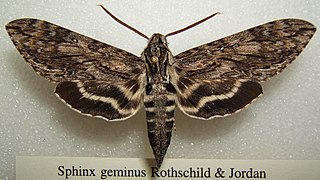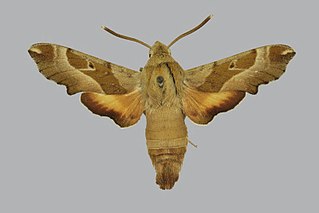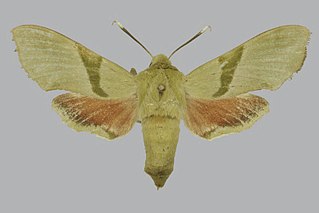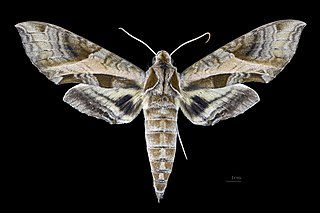
Cocytius lucifer is a moth of the family Sphingidae first described by Walter Rothschild and Karl Jordan in 1903.

Protambulyx goeldii is a species of moth of the family Sphingidae first described by Walter Rothschild and Karl Jordan in 1903. It is found in Brazil, Colombia, Guyana, Bolivia, southern Nicaragua, Costa Rica and probably Panama.

Lintneria geminus, the gemmed sphinx, is a moth of the family Sphingidae. The species was first described by Walter Rothschild and Karl Jordan in 1903. It is found from Mexico to Honduras and Nicaragua with an occasional stray into Texas.

Callionima nomius, the fan-tailed bark moth, is a moth of the family Sphingidae. The species was first described by Francis Walker in 1856.

Xylophanes tersa, the tersa sphinx, is a moth of the family Sphingidae. The species was first described by Carl Linnaeus in 1771. It is found from the United States, through Mexico, the West Indies and Central America and into parts of South America. An occasional stray can be found as far north as Canada.

Eumorpha elisa is a moth of the family Sphingidae.

Eumorpha triangulum is a moth of the family Sphingidae.

Eumorpha typhon, the Typhon sphinx, is a moth of the family Sphingidae. The species was first described by Johann Christoph Friedrich Klug in 1836.

Eumorpha vitis, known as the vine sphinx, is a moth of the family Sphingidae.

Proserpinus clarkiae, or Clark's sphinx, is a moth of the family Sphingidae. The species was first described by Jean Baptiste Boisduval in 1852. It is known from British Columbia and Washington south through California to Baja California, east to Idaho, Wyoming and Utah. The habitat consists of oak woodland and pine-oak woodland in foothills.

Proserpinus lucidus, the Pacific green sphinx or bear sphinx, is a moth of the family Sphingidae first described by Jean Baptiste Boisduval in 1852.

The willowherb hawkmoth is a moth in the family Sphingidae. The species was first described by Peter Simon Pallas in 1772.

Proserpinus is a genus of moths in the family Sphingidae, the sphinx moths or hawk moths. Species of the genus are native to North America with the exception of P. proserpinus, which has a much larger range extending from Asia to Africa. The genus was erected by Jacob Hübner in 1819.

Dolbogene is a monotypic moth genus in the family Sphingidae erected by Walter Rothschild and Karl Jordan in 1903. Its only species, Dolbogene hartwegii, or Hartweg's sphinx, was first described by Arthur Gardiner Butler in 1875. It is found from Texas and southern Arizona to Mexico and Guatemala. Only a small number have been caught and not much is known about the biology of this species.

Proserpinus gaurae, the proud sphinx moth, is a moth of the family Sphingidae. The species was first described by James Edward Smith in 1797. It is found from Texas and Louisiana east to northern Florida, north to Alabama, Missouri, northern Georgia and South Carolina. It may range as far south as northern Mexico.

Proserpinus terlooi, the Terloo sphinx moth, is a moth of the family Sphingidae first described by Henry Edwards in 1875. It is found from southern Arizona to Sonora in Mexico.

Euproserpinus phaeton, the Phaeton primrose sphinx moth, is a moth of the family Sphingidae. the species was first described by Augustus Radcliffe Grote and Herbert C. Robinson in 1865. It is found in North America from California south to Baja California Sur and further into Mexico. It has also been reported in south-western Arizona.

Eumorpha adamsi is a species of moth in the family Sphingidae. It was described by Walter Rothschild and Karl Jordan, in 1903, and is known from Venezuela, Brazil, Bolivia and Paraguay but is probably present throughout most of South America.

Eumorpha megaeacus is a moth of the family Sphingidae.

Adhemarius globifer is a species of moth in the family Sphingidae. It was described by Harrison Gray Dyar Jr. and 1912, and is found from Mexico to southern Arizona.




















